Hiroshima [20/07]
Arriving in Miyajima island
I arrived at Miyajima-guchi tram terminal at 8.50am. The tram was packed with kids three quarter into the journey. Nevertheless, I managed to get off fast and hopped onto the ferry. There are two ferry companies serving the route to Miyajima island. The Matsudai and the JR. As I have bought the 2-day free pass, I can only use the Matsudai ferry. I did not know which is which initially, so I just walked to the ferry gate and hopped on the first ferry waiting there.
The ferry ride takes around 10mins. It provides passengers with a beautiful view of Miyajima island. There are 3 floors to the ferry. The 1st is for vehicles, the 2nd is an air-condition room and the 3rd is al fresco. I went straight to the 3rd. Here is a photo scene I took from there.
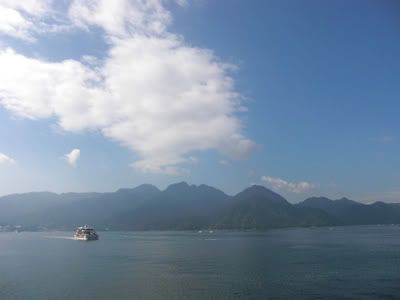
There is a Tourist Information Centre at the ferry terminal in Miyajima. I took the Misen (彌山) map and the highlight of the day - Kangensai Festival (管絃祭). After reading through the festival description, a change of plan has been decided. I will be at the Itsukushima Shrine (厳島神社) at 4pm to watch their portable shrine departure ceremony. When I was doing my research, I did not know where the shrine boats were departing from. Now everything became clear. I also plan to visit the Jinja in the morning as the high tide will be at 10am. The famous sight of Miyajima only happens during high tide.
Miyajima is also famous for its many deers like Nara. Here is a photo of the deers pushing down a bicycle and eating the maps. The owner of the bicycle is only next to it.
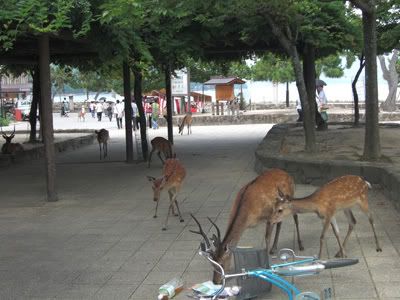
Itsukushima Shrine
The famous sight of Miyajima. It is high tide. You may ask why is the Torii gate in the middle of the sea. Well, in the past, visitors are forbidden on the island and the only way to the island is via the Itsukushima Shrine. The shrine design is also somewhat similar to that of a pier. Thus ships going to the island have to pass by this torii gate and straight to the jinja. They cannot land on the shores of the island. From this photo, the size of the torii gate may not be entirely known. In the subsequent photos below, you will see the actual size relative to the boats and people. It is really huge. That is why it is call otorii - big torii gate.

Here is Itsukushima Shrine. It cost 300Yen for the entrance. I can enter and leave anytime I like throughout the day. Here is a scene at high tide. To see it at low tide, please scroll down below and you can compare between the two photos.
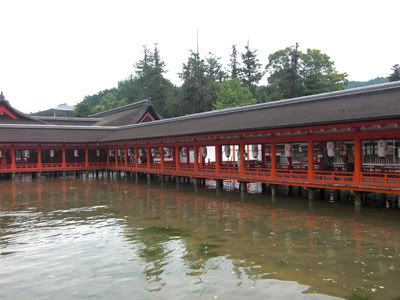
There are fewer visitors in the morning, thus I am able to capture the unique symmetric architecture.
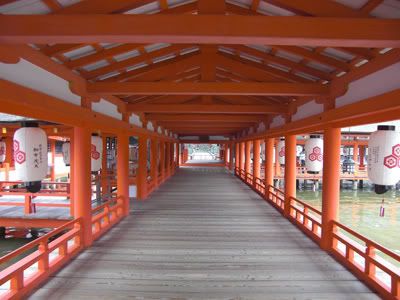
A curved bridge leading out. A tour guide leading a group of university students explain in Japanese that this bridge is unique in that there are no stairs. Oh ya!! I didn't actually notice that. Only find the shape to be fascinating.

The festival boats docked at the shrine. I heard from a lady who is saying in Japanese that the boats will depart at 10am; at the peak of the high tide. Hmm... That means it is best that I remain around to see the boats row out of the shrine. It will be quite an exciting scene.
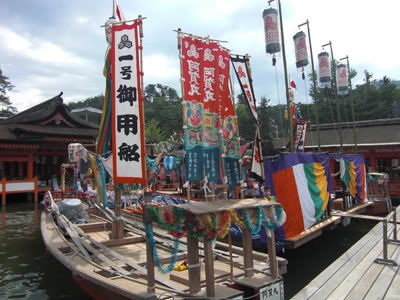
I have captured a video of the boats rowing out of the pier, with their drums beating.
The main festival boat passing through the torii gate. Notice how large the gate is. It can easily allow a full length boat to go through.
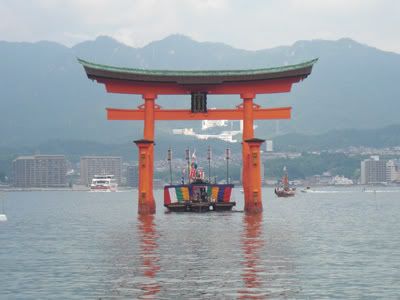
Daisho-in Temple
The Daisho-in (大聖院) temple is one of the recommended temples to visit in Miyajima island by several tourist guides. The aura surrounding the temple is just amazing! It has a very grandeur yet simple feel to it. Visitors to the temple will feel all their worries disappear and be at peace with the surroundings.
Here is the flight of stairs leading up to the main temple compound. Notice there are red leaves to the right, the scene is heavenly.
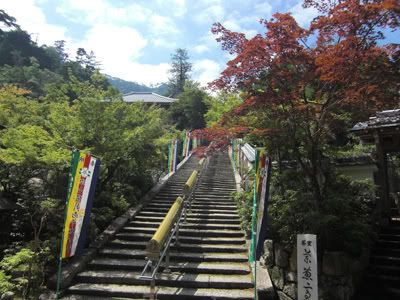
To the left of the entrance is a route where visitors can observe the 500 Arahants.
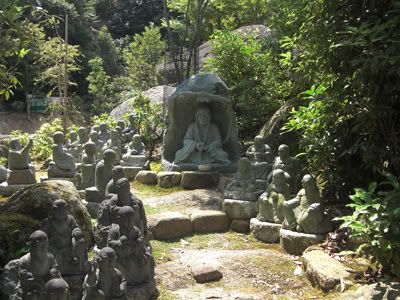
The route leads off to the middle of the flight of stairs. At the centre piece are prayer wheels where visitors can turn when they walk up or down the stairs.
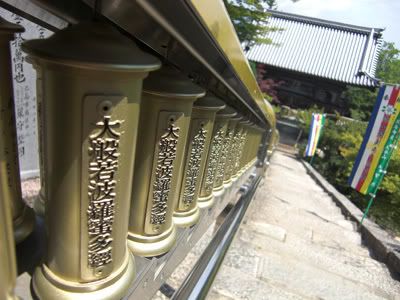
A representation of Kannon(観音) with the temple's pagoda at the background.

This temple belongs to the Shingon branch of Japanese Buddhism. In the main hall, I noticed the picture of His Holiness The 14th Dalai Lama. I saw many of His Holiness photos in there with the temple's abbot.
Another flight of stairs leading to the teaching hall.
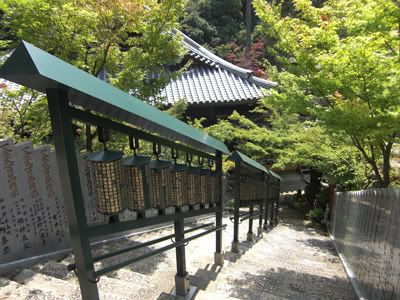
A hall with many lamps. This hall is located in a natural cave.
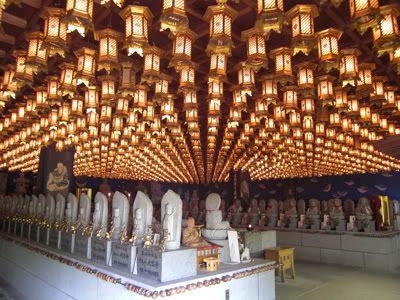
It is in this temple that I noticed a DVD video on Kukai, the founder of Shingon Buddhism. It cost 4,500Yen. As I am quite fascinated by Buddhist videos, I just bought it. Though I clarified with the temple staff that the DVD has absolutely no subtitles or any other language other than Japanese.
I refilled my 500ml tea bottle with the temple herbal tea. The weather is getting really hot and it is now 11am. The temple herbal tea will quench my thirst at the crucial moments when I am going up Mt Misen next.
Travelling to Mt Misen
I have a quick lunch of Udon at a simple hut on the way up to the cable car station. From there I took the ropeway up Mt Misen. There is firstly the ropeway leading to a height of 367m, from there I need to transit to a cablecar to the final stop of 430m.
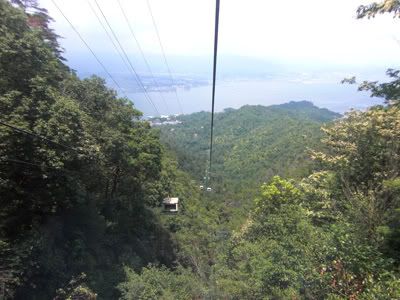
At the end of the cablecar ride, we are given a breathtaking view of the famous inner sea of Japan. It borders Shikoku and the main Japan island.
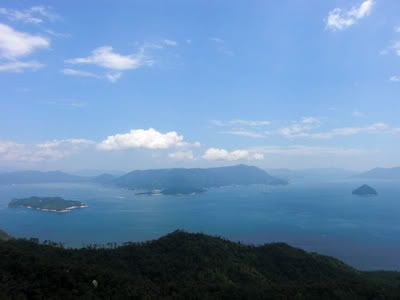
A notice at the cable car station mention that Mt Misen is a monkey kingdom. There are lots of monkeys hanging around the cable car station.

From the cable car station is another 100m climb or 20 mins climb up to the peak. At the halfway point is the Misenhondo Hall, where Kukai is said to teach here. Coincidentally at this time, it started raining, so I took refuge at the temple. After the rain, a fog envelope the mountain, giving it a mystical feel.

In the Reikado Hall which is directly opposite the teaching hall, it is said to contain the flame that has been burning for more than a thousand years. While helping an elderly japanese couple with the pot cover, I noticed warm water is being heated in there where visitors can have a seep. So I also tried it, it taste nice - natural mountain water. It is also this flame that is being used to light the flame of peace in Hiroshima peace park.
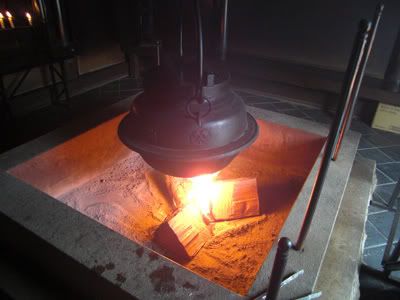
The rain stopped after 30mins and I continued my way to the peak. This is the picturesque scene. The clouds are below the peak and are flowing through like sea of clouds. It is really a fabulous sight.
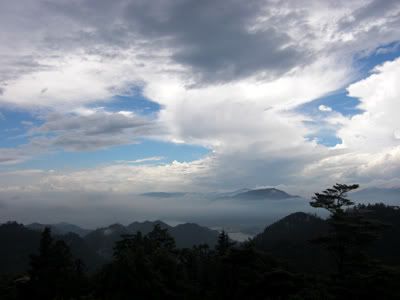
Here is me at the peak. An accomplishment.
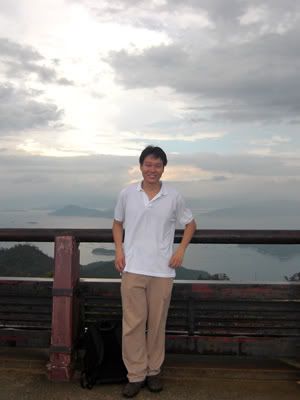
Thankfully I bought the 2-day free pass, so I took the cablecar back down to the foot of the mountain. Climbing the 100m mountain top is already somewhat exhausting. I have read other visitors blog who attempted to climb the 530m mountain and were completely KO by the time they reached the top. It also rained, thus mountain climbing is definitely out. Maybe the spring or autumn season will be a better time to attempt it.
Kangensai Festival
When I got down from the mountain top, the sea which I saw in the morning was gone. It is now low-tide and the mega torii gate is exposed. Hordes of people are walking around the gates for photoshot.
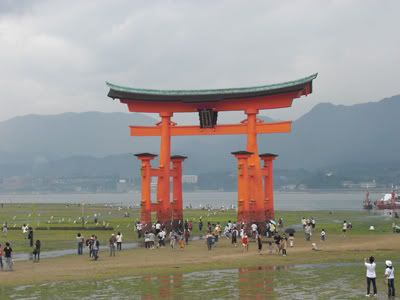
I made a quick detour to the city to catch the mega rice scoop. Miyajima is famous for its wooden rice scoop.
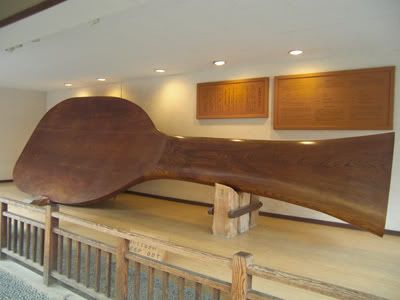
It is now back to Itsukushima shrine. If you compare this photo with a previous one taken above, you can notice the difference between high tide and low tide.
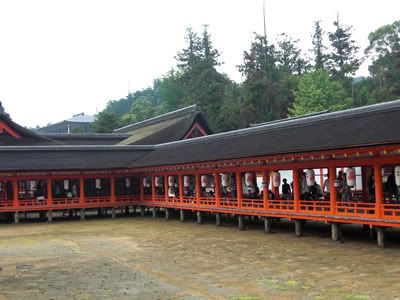
The festival ritual started in 4pm. It started raining rather heavily at this time. Thankfully the ritual is held indoors, thus I can just sit and observe the ceremony. By around 5pm, they are getting ready to move the portable shrine to the boats that have been moved out early this morning.
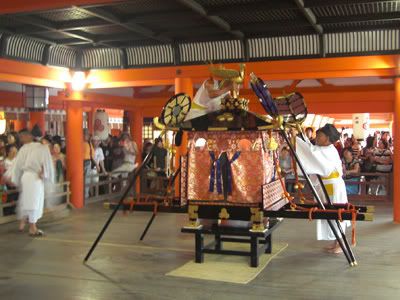
When they started moving out, the rain has yet to stop. The portable shrine and kids are covered with rain coats. But I am confident the rain is going to stop soon. Though it is still somewhat heavy. All I can say is that I believe in the combine karma of all the people and for the smooth running of this festival, the rain will stop soon. Thus I get ready to leave the shrine to catch a better glimpse of the proceedings.
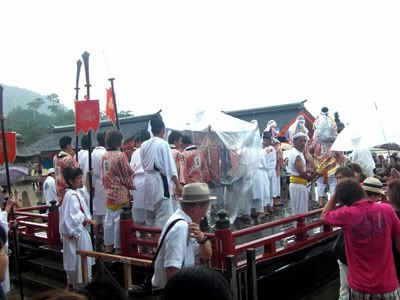
Eventually the rain really stopped! This is an amazing sight. A long line of people walking through the torii gate to the boat waiting at the sea. It is almost divine. The sun pierce through the clouds onto the land below. Green sea grass covered the entire land against the distant sea. The people are marching out with religious conviction (or curiousity). I took many pictures of this scene and really can't take my eyes off it. It is similar to the sight I saw in Nara of Todaiji: heavenly, divine, amazing.

I started to make a move at 5.40pm as the boats are departing. I noticed many Kaki (Oyster) stores in the Miyajima street. As I have not drank much water today, I think it is best for me to avoid such exotic food. Oyster is also not my favourite (I went for a buffet once in Singapore and they were having Oysters, I only took one and that's all).
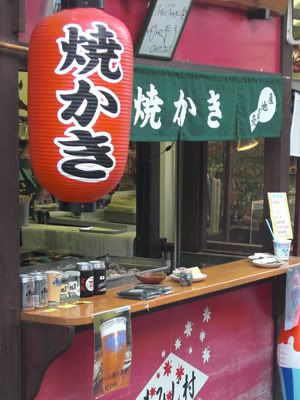
I took the 6.15pm ferry from the terminal. Coincidentally, it passes by the Kangensai boats. People pay 10,000+ Yen just to follow along the Kangensai boats in the sea. For me, it is just perfect timing when my ferry passes by them. It is close to sundown, so I took a closeup photo of the boats when my ferry travelled past them.

Jizozen Shrine
The boats are scheduled to arrive at Jizozen shrine (地御前) at 7.50pm. After a quick dinner of Soba at Miyajima-guchi, I took the tram to the Jizozen shrine which is 6mins away. There are already hordes of people around the shrine when I arrived at 7.20pm. Here is the twilight view of the scene in front of Jizozen shrine.
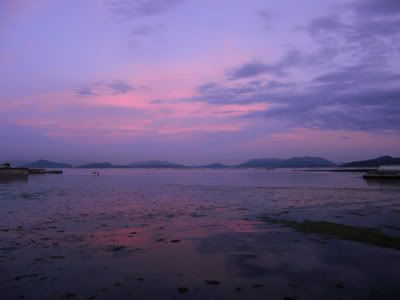
The shrine has lots of shops selling food and people are dancing in the shrine. It reminds me of the traditional tibetan dance which I have seen before. Even the dance rhythm feels similar.
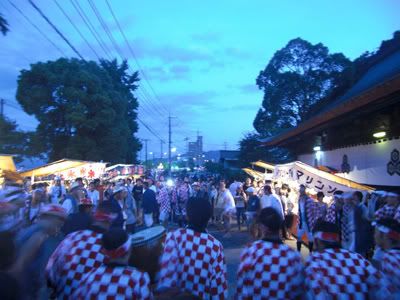
The video of the dance is captured below
The Kangensai boats have finally arrived. I noticed there are two fires burning on the main shrine boat. It is fantastic on how they have it under control in a wooden boat.
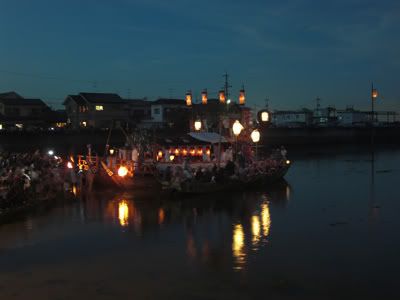
I left around 8pm for my accommodation.